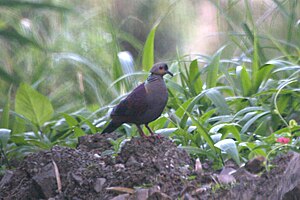Jamaican earth pigeon
| Jamaican earth pigeon | ||||||||||
|---|---|---|---|---|---|---|---|---|---|---|

Jamaican earth pigeon |
||||||||||
| Systematics | ||||||||||
|
||||||||||
| Scientific name | ||||||||||
| Geotrygon versicolor | ||||||||||
| ( Lafresnaye , 1846) |
The Jamaican earth dove ( Geotrygon versicolor ), also called short -headed dove , is a species from the order of the pigeon birds. It occurs exclusively in Jamaica . The IUCN classifies this species as near threatened . The population figures are not known, it is assumed that due to the conversion of forest into agricultural areas and increasing infrastructure development, the habitats of the species and thus also the population figures will decline.
The Jamaican pigeon has a name that sounds similar to the Jamaican earth pigeon, but it belongs to the sonic swinging pigeon and its distribution is not limited to Jamaica.
Appearance
The Jamaican earth pigeon reaches a body length of 30 centimeters. It is thus slightly larger than a laughing pigeon , but smaller than a city pigeon . It is a compactly built pigeon that spends most of its time on the ground. Compared to the other species of American earth pigeons , the Jamaican earth pigeon has a relatively large head. Characteristic of the species is the short, backward-facing feather head, which is formed by slightly elongated feathers on the back of the head.
The head and neck of the Jamaican Earth Dove are gray and shiny bronze green. The forehead is dark gray. The mantle and the wing covers are dark brown with a reddish-purple tinge. The back, rump and tail are greenish blue. The hand wings are red-brown, the arm wings are dark green. The chest is gray and turns a wine red to the belly. The beak is dark gray, the iris red. The gender dimorphism is slightly pronounced. The females have slightly lighter tail-coverts and are more brown on the neck and belly.
Habitat and behavior
The Jamaican earth pigeon is a resident bird within its range. It mainly inhabits humid and rain-humid mountain forests at altitudes between 100 and 1,800 meters. It only feels at home where there is dense, undisturbed undergrowth in the forests and therefore reacts sensitively to changes in habitat such as logging. She does not colonize secondary forests, even if she occasionally uses them for foraging. The species is generally very shy and is mainly observed individually or in pairs. It is rarely exposed. Like other American earth pigeons, it arises to rest and during the night. The food spectrum includes seeds, small fruits, insects and their larvae as well as snails. The Jamaican earth dove has a particular fondness for the seeds of the castor tree .
The breeding season lasts from March to June. The courtship takes place on the ground. The male presses the beak vertically downwards, ruffles the back plumage and presses the neck, head and beak onto the chest plumage. The tail is strongly lowered so that the male has an almost round body shape when viewed from the side.
The nest is a fragile platform made of twigs that is built with small roots and dead leaves in the thick undergrowth. Nests are usually found one to one and a half meters above the surface of the earth. The clutch consists of one or two creamy white eggs. The breeding season is about 13 days. The young birds can fledge after twelve to thirteen days.
Keeping in human care
The Jamaican Earth Dove was first shown at London Zoo in 1860. The first breeding succeeded in 1901. Offspring came mainly in the 1950s. At least at times, the low number of breeding pairs led to increasing inbreeding depression and thus to very low reproduction rates. In 1999 Alois Münst described the species as a relatively common species in European wild pigeon keeping.
supporting documents
Individual evidence
- ↑ BirdLife Factsheet , accessed June 11, 2009
- ↑ Rösler, p. 219
- ↑ Gibbs, p. 377
- ↑ Gibbs, p. 377
- ↑ Rösler, p. 219
- ↑ Münst, p. 72
literature
- David Gibbs, Eustace Barnes and John Cox: Pigeons and Doves - A Guide to the Pigeons and Doves of the World . Pica Press, Sussex 2001, ISBN 90-74345-26-3 .
- Alois Münst and Josef Wolters: Tauben - The species of wild pigeons , 2nd expanded and revised edition, Verlag Karin Wolters, Bottrop 1999, ISBN 3-9801504-9-6 .
- Gerhard Rösler: The wild pigeons of the earth - free living, keeping and breeding . M. & H. Schaper Verlag, Alfeld-Hannover 1996, ISBN 3-7944-0184-0 .
Web link
- Geotrygon versicolor inthe IUCN 2013 Red List of Threatened Species . Listed by: BirdLife International, 2012. Retrieved March 17, 2014.